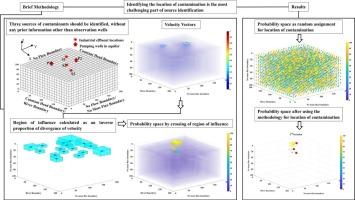A semi-probabilistic Bayesian method to identify the number and location of potential sources in 3D unconfined aquifer using limited observed concentration
IF 3.5
3区 环境科学与生态学
Q2 ENVIRONMENTAL SCIENCES
引用次数: 0
Abstract
Source identification of a contaminant has always been challenging for accurately modeling groundwater transport. Source identification problems are classified into several parts, such as identifying the location of contamination, the strength of contamination, the time the contaminant is introduced into the groundwater, and the duration of its activity. Identifying the sources considering all the parts as variables increases the computational complexity. Reducing the number of variables in source identification problems is necessary for a swift solution through optimization approaches. The most challenging variable in source identification modeling is the location of contamination, as it is a discrete variable for almost all the numerical solutions of groundwater models. In this research study, we have created a methodology to narrow the location of contamination from a random distribution throughout the aquifer to a reasonable number of probable locations. Although methods to identify the location of contamination were devised earlier, we have attempted an approach of combining a particle tracking approach with Bayesian method of updating the probabilities as a novel approach, where the observation data is limited. We have considered the aquifer parameters and observation well data and devised a method with a Lagrangian approach to particle movement to identify the potential source locations. We have refined the source locations to a narrower probability distribution using the Bayesian method of updating the probability through new information of refined grid space. We have tested the models to identify the potential sources with different hypothetical problems and identified the sources in advective dominant transport with an average probability of 0.53, diffusion dominant transport with an average probability of 0.62, heterogenous soils with an average probability of 0.99, anisotropic aquifer with an average probability of 0.91, and aquifer with irregular boundary with an average probability of 0.96 to identify the location nearest to the actual contaminant source. The results are satisfactory in identifying the number of potential sources with an accuracy of 88 % (15 identified out of 17 sources with a probability greater than 0.4) and their locations in the aquifer with a probability of 0.223 for exact location identification. The probability of finding a source nearest to the actual location is 0.745 at an average distance of 11.6 m from the actual source location.

利用有限的观测浓度,采用半概率贝叶斯方法确定三维无约束含水层中潜在污染源的数量和位置。
要准确模拟地下水的迁移,污染物的来源识别一直是个难题。污染源识别问题分为几个部分,如识别污染位置、污染强度、污染物进入地下水的时间及其活动持续时间。将所有部分都视为变量来识别污染源会增加计算的复杂性。要想通过优化方法快速解决问题,就必须减少污染源识别问题中的变量数量。污染源识别建模中最具挑战性的变量是污染位置,因为它是几乎所有地下水模型数值解法中的离散变量。在这项研究中,我们创建了一种方法,将污染位置从整个含水层的随机分布缩小到合理数量的可能位置。虽然确定污染位置的方法早有设计,但在观测数据有限的情况下,我们尝试将粒子跟踪方法与更新概率的贝叶斯方法相结合,作为一种新方法。我们考虑了含水层参数和观测井数据,设计了一种采用拉格朗日粒子运动方法来确定潜在污染源位置的方法。我们利用贝叶斯方法,通过细化网格空间的新信息更新概率,将水源位置细化为较窄的概率分布。我们用不同的假设问题测试了识别潜在污染源的模型,在平流主导传输中识别污染源的平均概率为 0.53,在扩散主导传输中识别污染源的平均概率为 0.62,在异质土壤中识别污染源的平均概率为 0.99,在各向异性含水层中识别污染源的平均概率为 0.91,在不规则边界含水层中识别污染源的平均概率为 0.96,从而识别出距离实际污染源最近的位置。在确定潜在污染源数量方面,结果令人满意,准确率为 88%(17 个污染源中确定了 15 个,概率大于 0.4),在含水层中确定污染源位置的准确概率为 0.223。在距离实际水源位置平均 11.6 米的地方,找到最接近实际位置的水源的概率为 0.745。
本文章由计算机程序翻译,如有差异,请以英文原文为准。
求助全文
约1分钟内获得全文
求助全文
来源期刊

Journal of contaminant hydrology
环境科学-地球科学综合
CiteScore
6.80
自引率
2.80%
发文量
129
审稿时长
68 days
期刊介绍:
The Journal of Contaminant Hydrology is an international journal publishing scientific articles pertaining to the contamination of subsurface water resources. Emphasis is placed on investigations of the physical, chemical, and biological processes influencing the behavior and fate of organic and inorganic contaminants in the unsaturated (vadose) and saturated (groundwater) zones, as well as at groundwater-surface water interfaces. The ecological impacts of contaminants transported both from and to aquifers are of interest. Articles on contamination of surface water only, without a link to groundwater, are out of the scope. Broad latitude is allowed in identifying contaminants of interest, and include legacy and emerging pollutants, nutrients, nanoparticles, pathogenic microorganisms (e.g., bacteria, viruses, protozoa), microplastics, and various constituents associated with energy production (e.g., methane, carbon dioxide, hydrogen sulfide).
The journal''s scope embraces a wide range of topics including: experimental investigations of contaminant sorption, diffusion, transformation, volatilization and transport in the surface and subsurface; characterization of soil and aquifer properties only as they influence contaminant behavior; development and testing of mathematical models of contaminant behaviour; innovative techniques for restoration of contaminated sites; development of new tools or techniques for monitoring the extent of soil and groundwater contamination; transformation of contaminants in the hyporheic zone; effects of contaminants traversing the hyporheic zone on surface water and groundwater ecosystems; subsurface carbon sequestration and/or turnover; and migration of fluids associated with energy production into groundwater.
 求助内容:
求助内容: 应助结果提醒方式:
应助结果提醒方式:


